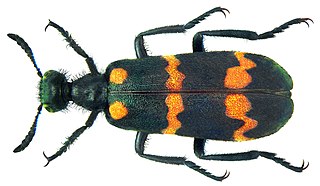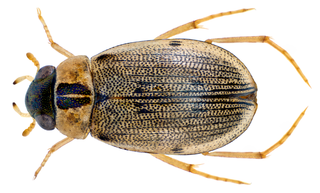
Histeridae is a family of beetles commonly known as clown beetles or hister beetles. This very diverse group of beetles contains 3,900 species found worldwide. They can be easily identified by their shortened elytra that leaves two of the seven tergites exposed, and their geniculate (elbowed) antennae with clubbed ends. These predatory feeders are most active at night and will fake death if they feel threatened. This family of beetles will occupy almost any kind of niche throughout the world. Hister beetles have proved useful during forensic investigations to help in time of death estimation. Also, certain species are used in the control of livestock pests that infest dung and to control houseflies. Because they are predacious and will even eat other hister beetles, they must be isolated when collected.

Trogidae, sometimes called hide beetles, is a family of beetles with a distinctive warty or bumpy appearance. Found worldwide, the family includes about 300 species contained in four or five genera.

Dermestidae are a family of Coleoptera that are commonly referred to as skin beetles. Other common names include larder beetle, hide or leather beetles, carpet beetles, and khapra beetles. There are over 1,800 species described.

Cleridae are a family of beetles of the superfamily Cleroidea. They are commonly known as checkered beetles. The family Cleridae has a worldwide distribution, and a variety of habitats and feeding preferences.

Latridiidae is a family of tiny, little-known beetles commonly called minute brown scavenger beetles or fungus beetles. The number of described species currently stands at around 1050 in 29 genera but the number of species is undoubtedly much higher than this and increases each time a new estimate is made.

Melolonthinae is a subfamily of the scarab beetles. It is a very diverse group; distributed over most of the world, it contains over 11,000 species in over 750 genera. Some authors include the scarab subfamilies Euchirinae and Pachypodinae as tribes in the Melolonthinae.

Mitopus morio is a species of harvestman arachnid belonging to the family Phalangiidae.

Syntelia is a genus of beetles. It is the only genus in the family Synteliidae. There are seven known species, which are native to high-elevation regions in southern North America from central Mexico to Guatemala, and in eastern Asia, from India to Japan and eastern Russia. They are generally associated with rotting logs, typically found under bark, though the Mexican species S. westwoodi has been found inside large decaying columnar cacti. Adults and larvae are predatory, feeding on insect larvae. A fossil species, Syntelia sunwukong, is known from the Late Cretaceous (Cenomanian) aged Burmese amber of Myanmar. Adults are around 1–3.5 centimetres (0.39–1.38 in) in length. The characteristics of the family and genus include geniculate antennae with 3-segmented club, elongate body, narrowly separated coxae and tarsi with bisetose empodia. Only one abdominal segment is exposed behind elytra. The genus described by John O. Westwood in 1864, while the family was erected by George Lewis in 1882. They are members of Histeroidea, which also includes clown beetles (Histeridae).

Gelae is a genus of round fungus beetles belonging to the family Leiodidae. The beetles are found in different parts of Central and North America. They are small and rounded, feeding on slime moulds. They were originally placed in the genus Agathidium following the discovery of the first species, G. cognatum, in 1878. The taxonomic position was revised with description of new species in 2004 by American entomologists Kelly B. Miller and Quentin D. Wheeler. Upon creation of the new genus, the five new species are Gelae baen, G. belae, G. donut, G. fish, and G. rol.

Hycleus pustulatus is a species of blister beetle found in India, Sri Lanka, China and Java.

Lamprolina is an Australian genus of leaf beetles (Chrysomelidae) found in Victoria, New South Wales, and Queensland.

Berosus pulchellus, is a species of water scavenger beetle found in Oriental, Australasian, Afrotropical and Palaearctic regional countries such as India, Sri Lanka, Hong Kong, Japan, Iran, Cambodia and Australia.
Hydrovatus acuminatus, is a species of predaceous diving beetle found in Oriental and African regions.

Hydaticus pacificus, is a species of predaceous diving beetle found in South and South East Asia.
Orphinus (Picorphinus) guernei, is a species of skin beetle found in Sri Lanka.
Orphinus funestus, is a species of skin beetle found in Sri Lanka.
Clambus ceylonicus, is a species of fringe-winged beetle endemic to Sri Lanka.
Clambus villosus is a species of fringe-winged beetle endemic to Sri Lanka.
Clambus pumilus, is a species of fringe-winged beetle endemic to Sri Lanka.
Decellebruchus walkeri is a species of leaf beetle found in India, Kenya, Sri Lanka and Thailand.













